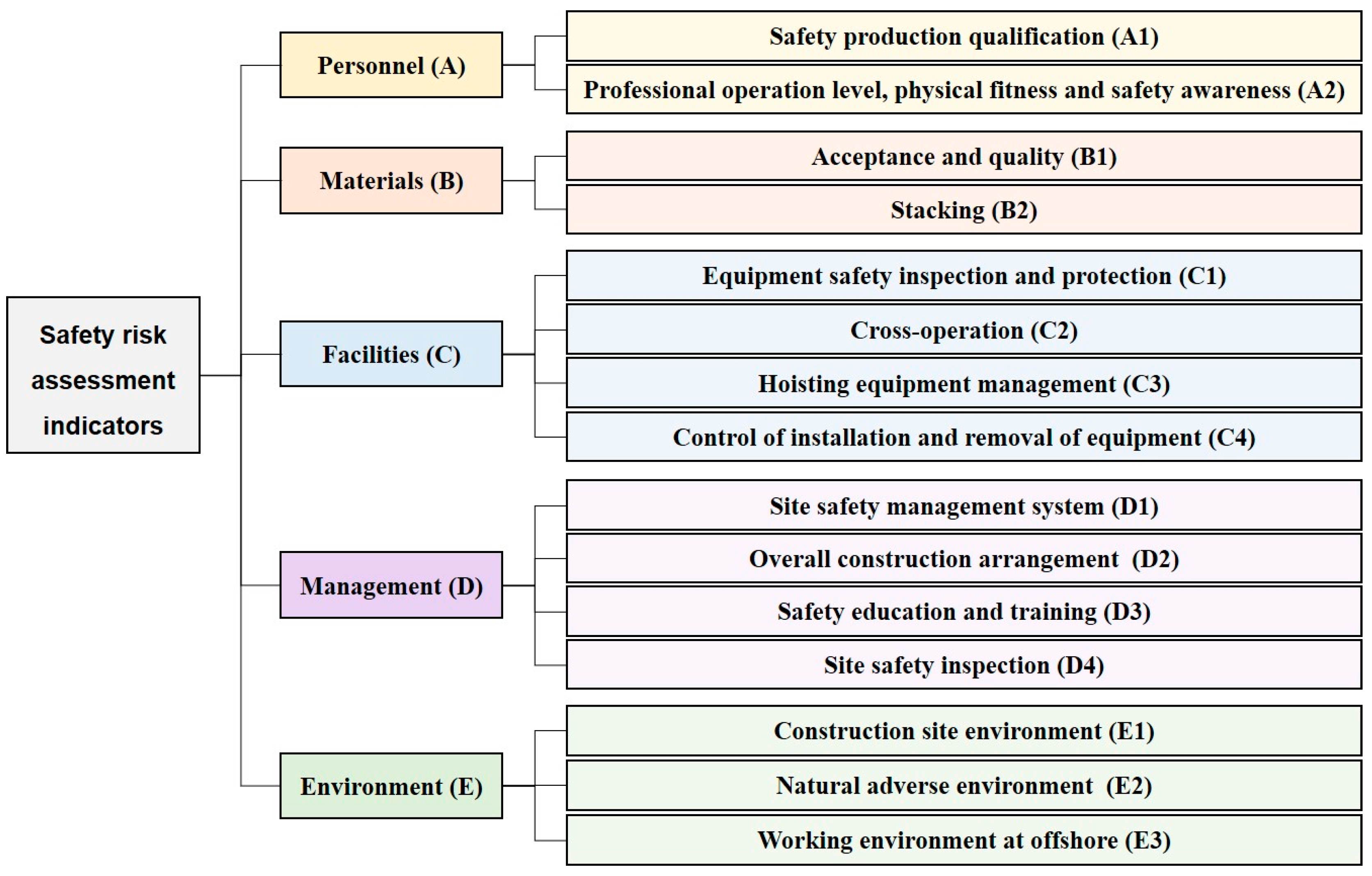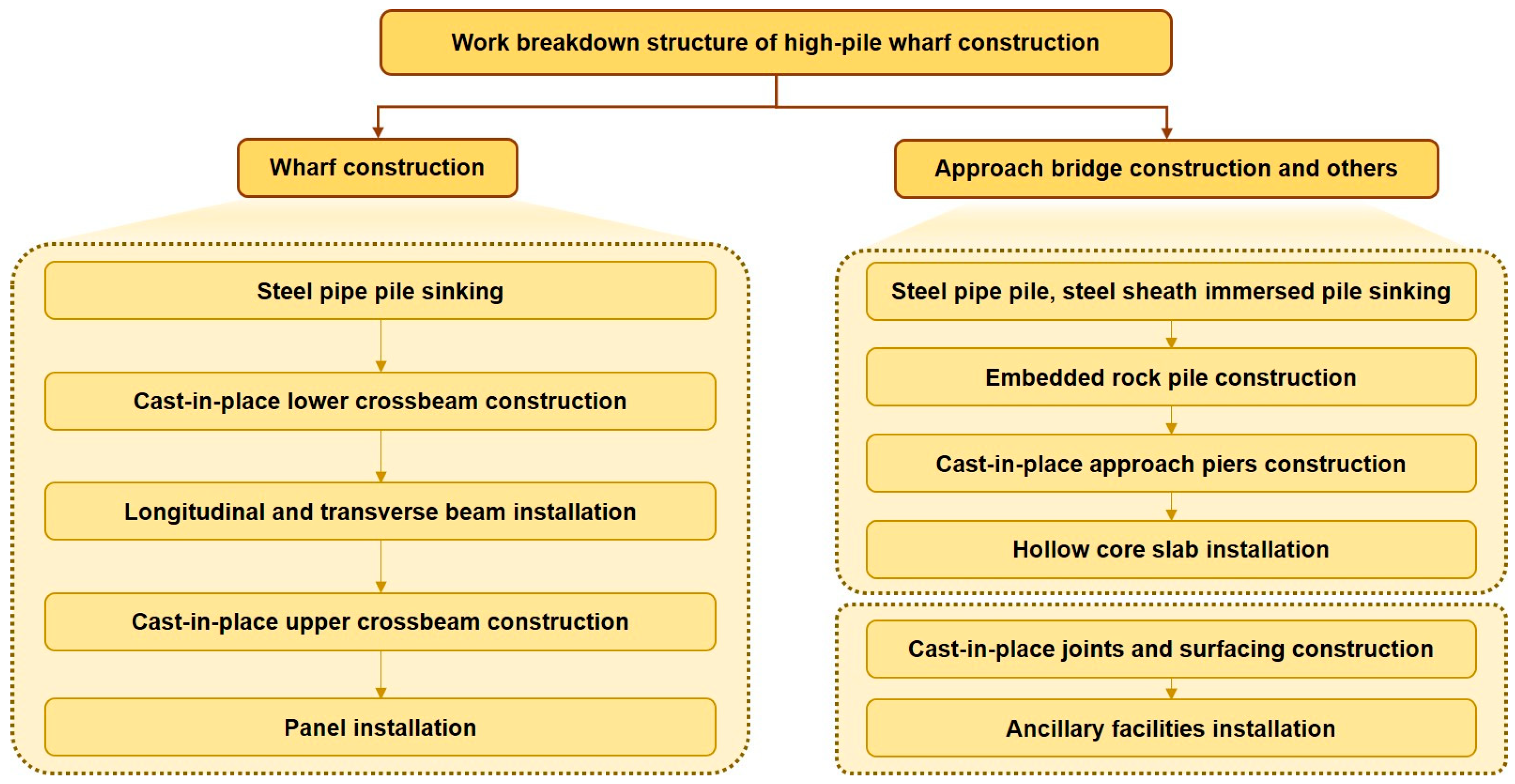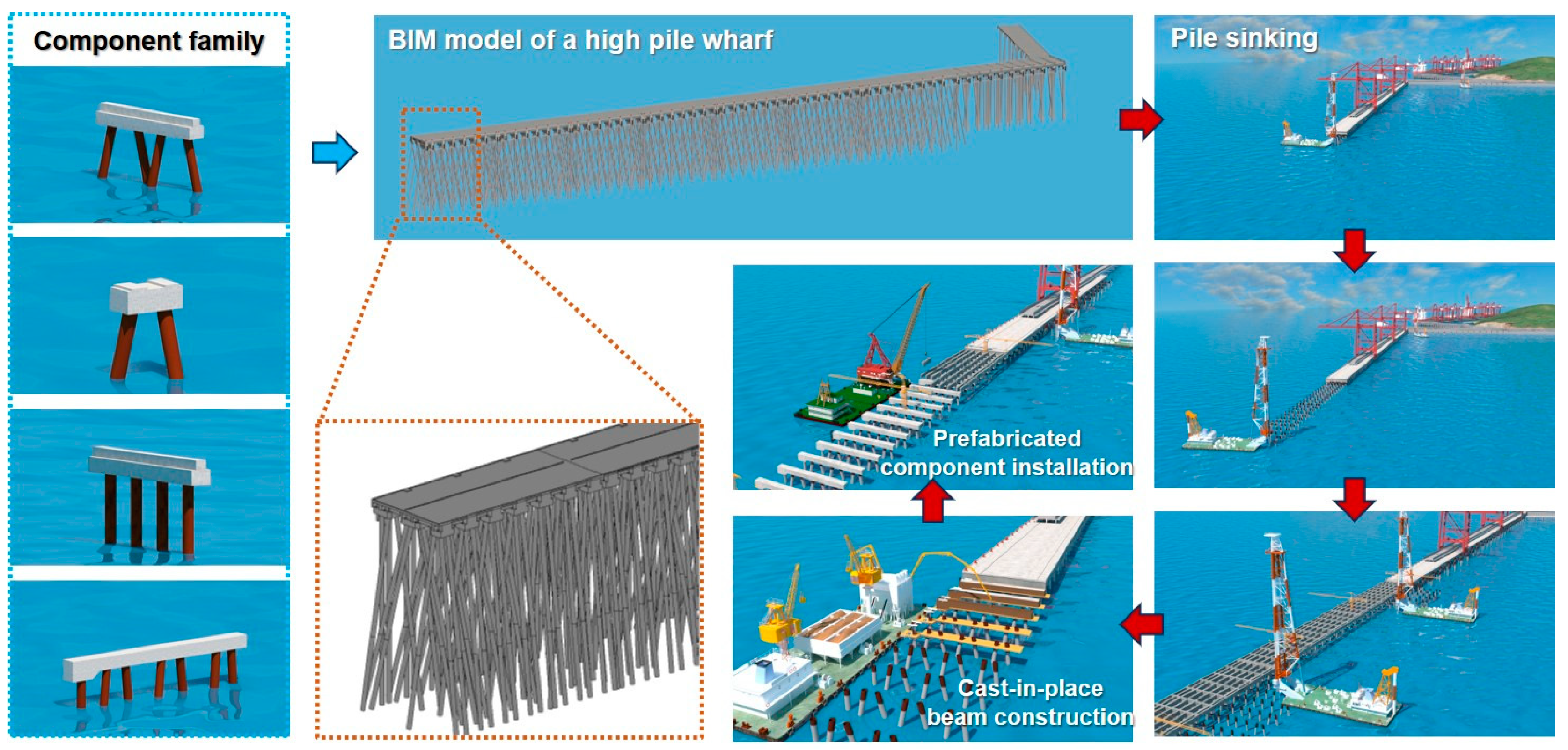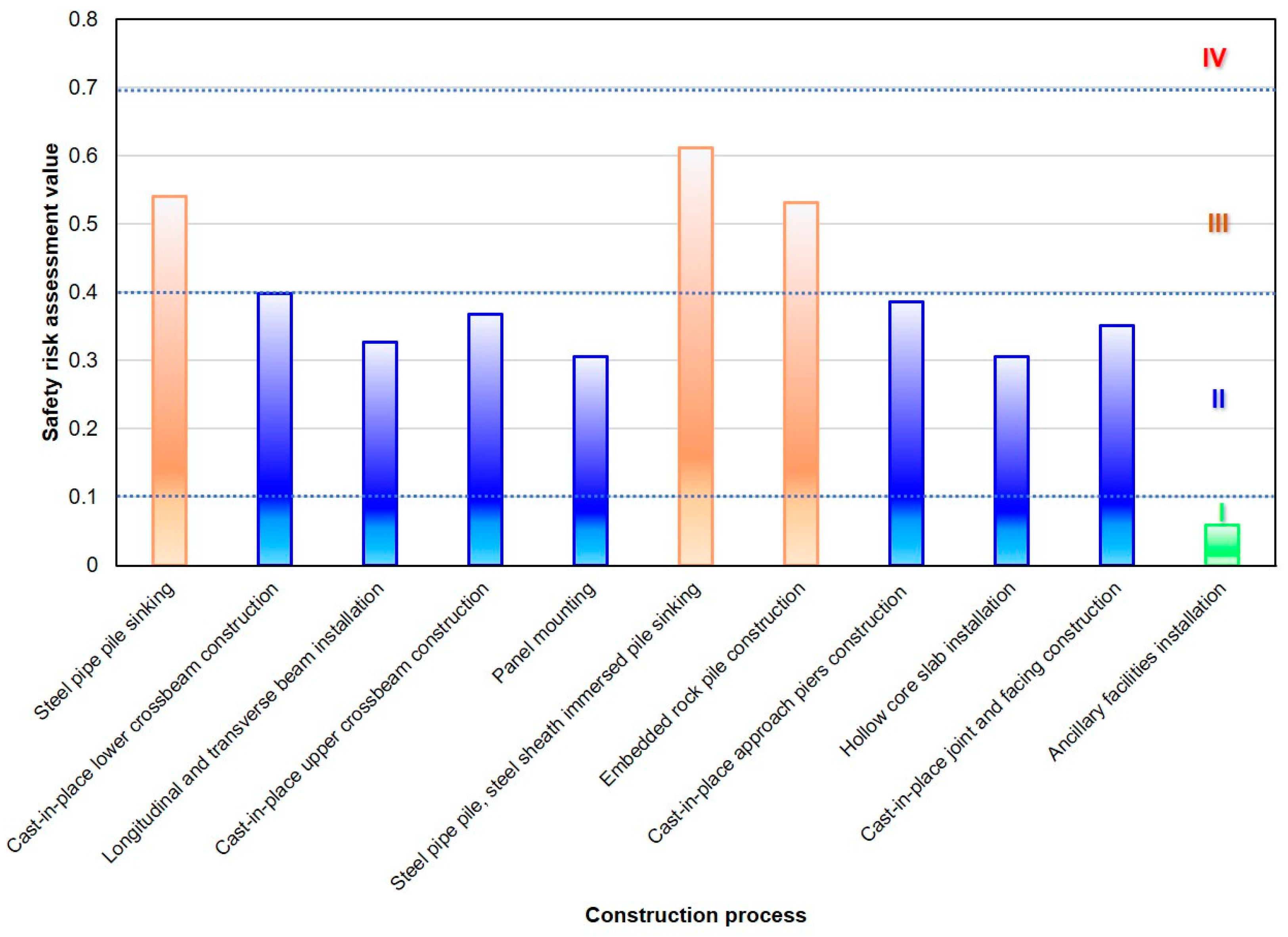Construction Safety Risk Assessment of High-Pile Wharf: A Case Study in China
Abstract
:1. Introduction
2. Theory of Safety Risk Assessment
- (1)
- Systematic principle. The construction safety risk-influencing factors should cover all aspects of the construction management of high-pile wharves and at the same time conform to the actual situation of the construction industry and the construction characteristics of high-pile wharves.
- (2)
- Principle of independence. To determine the relationship between the influencing factors, it is necessary to require that these factors are independent of each other. Therefore, it is especially important to select the appropriate influencing factors.
- (3)
- Targeted principle. The construction safety risk-influencing factors of high-pile wharf projects are numerous and quite complicated. Therefore, the factors with greater influence and representativeness should be selected in a targeted way.
- (4)
- Dynamic principle. Project construction is a dynamic and real-time changing process. Assessment indicators should be selected based on the actual project situation for dynamic identification, and evaluation indicators need to be constantly updated to satisfy the needs of high-pile wharf construction safety risk evaluations.
- (1)
- The professional scoring method refers to the use of professional work practices to assign values to different parameters that cannot be identified by an enterprise and analyze them, combining a number of professional points of view to arrive at a more intuitive result [6]. This approach is relatively simple and effective and is usually used in conjunction with other assessment tools in project design.
- (2)
- The analytic hierarchy process (AHP) is a network system weighting analysis method that integrates qualitative and quantitative considerations proposed by Saaty [40]. The core principle is that the research object is classified into several levels according to certain criteria, and each level of risk factors is identified based on expert assessments so as to find the factors that have the greatest impact on the research results. However, because the hierarchical analysis method is limited by the subjective judgment and professional ability of the researcher, it may also lead to the failure of the judgment of the project, so it is best to be applied together with other assessment tools.
- (3)
- The entropy weighting method is a way of assigning weights based on objective data, which is determined by the availability of data [41]. Entropy can be used as a measure of uncertainty, which is higher when data availability is low and lower when data availability is high. The entropy weighting method helps to extract valid information from the data set of multiple indicators and convert it into more accurate entropy values, thus obtaining more accurate indicator weights.
- (4)
- The fuzzy comprehensive evaluation (FCE) method can be utilized to identify complex objects with uncertainty [34]. By establishing the risk evaluation set and risk alternative set, constructing the factor weight set, the fuzzy relationship affiliation evaluation matrix, the single-factor fuzzy evaluation and the multi-factor fuzzy evaluation can be implemented, by which the comprehensive evaluation of assessment indexes is realized. The fuzzy insinuating relationship degree technique can effectively convert complex qualitative problems into quantitative forms, and it can also effectively solve the systematic problems of multi-objective uncertain objects. The logic of FCE is clear and easy to operate, so it has been widely applied to various kinds of engineering projects.
- (5)
- Neural network analysis can be regarded as an accurate assessment tool [42], which can effectively capture and characterize complex information, which can be used to infer and predict future trends based on this information. This technique can help researchers to obtain information more accurately and quickly, so that they can develop assessments more objectively and accurately. Despite its good self-learning ability and resistance to failure, neural network analysis still faces great challenges. Limitations in the number of samples, quality and selection of regions make its results very unpredictable.
3. Methodology
3.1. Determination of Safety Risk Assessment Indicators
3.2. Construction Safety Risk Assessment Algorithm
4. Results and Discussion
4.1. Project Overview and Construction Analysis
- (1)
- Restricted island operation and difficult resource organization: the project is an isolated island operation in the outer sea, which makes the transportation of materials and equipment difficult, and there is sea fog in spring, typhoons in summer and frequent cold air in winter, which reduces the actual number of days available for operation. The project schedule is of a high intensity and busy. A large number of resources, engineers, ships and machines and transport vehicles are invested in during the peak period, which makes the project organization difficult and puts forward very high requirements on the project safety construction.
- (2)
- Poor construction conditions and less effective operating time: the project construction area involves open sea, poor construction conditions. Wind and waves have a great impact on the safety of construction operations, and especially, the impact of long periods of surging waves cannot be ignored, and the project’s construction safety risks caused by the winter cold wave and summer tropical cyclones have a greater impact.
- (3)
- Work surface cross-operation, organization and coordination difficulties: the number of construction wharves, wharves and wharves net distance is small and close to the embankment, the workspace is crowded, the construction operation of the ship and machine interfere with each other and there is a cross-construction caused by the construction safety risk potential hazards.
4.2. BIM Model for Safety Risk Management of High-Pile Wharf Construction
4.3. Safety Risk Assessment of the High-Pile Wharf Construction
4.3.1. Determination of Indicator Weights
4.3.2. Safety Risk Score Calculation
- (1)
- SA: Before the construction of the project, a safety production qualification examination was carried out for the operators of the pile-sinking construction. The total score of the question paper was 100, the number of participants was 20 and the average score was 72.5, which gave A1 = 0.275. According to the age of the operators of the pile-sinking construction and the level of their professional skill certificate, it was obtained that A2 = 0.4911. Therefore, SA = A1 + A2 = 0.7661.
- (2)
- SB: It was found that the materials to be used in the construction of steel pipe piles included not only the prefabricated piles themselves but also ~15 kinds of materials such as iron parts, steel wire ropes, welding rods, concrete and reinforcing bars. The pass rate of acceptance and sampling inspection of each material was recorded and averaged to get B1 = 0.1164. Examining the stockpile sites and stockpile management practices for 16 kinds of materials yielded B2 = 0.35. SB = B1 + B2 = 0.4664.
- (3)
- SC: Based on the statistical results of the questionnaire, the weights of the four elements of the scheme layer were {0.15, 0.35, 0.3, 0.2}. By recording the frequency of safety checks and the protection measures taken, C1 = 0.2. According to the construction information, the pile sinking involved the crossover of 15 types of large-scale machinery, including piling vessels, motorized boats, marine piling hammers, cranes, forklifts and so on. The installation areas were generally identified and the dismantling operators were satisfied. Therefore, C2 = 0.6, C3 = 0.2 and C4 = 0.1. SC = 0.32.
- (4)
- SD: Based on the statistical results of the questionnaire, the weights of the four elements of the scheme layer were {0.25, 0.2, 0.25, 0.3}. According to the project management system and site situation, D1 = 0.3, D2 = 0.4, D3 = 0.25 and D4 = 0.05. SD = 0.23.
- (5)
- SE: According to the recorded visibility index for one year, the number of actual construction days, it was calculated that E1 = 0.125 and E2 = 0.11. The construction was located at open sea, E3 = 0.3. SE = E1 + E2 + E3 = 0.535.
4.4. BIM-Based Safety Risk Evaluation Platform
5. Conclusions
- (1)
- The construction safety risk assessment system contains physical parameters and safety risk indicators of each component, which can be used for safety risk assessments and visualization management during the construction of the high-pile wharf, providing a database, visualization analysis and management platform for the safety risk assessment of the high-pile wharf.
- (2)
- The accurate identification and categorization of construction safety risk factors are important prerequisites for safety risk assessment in high-pile wharf construction. The construction risk assessment system based on hierarchical analysis proposed in this paper was constructed by the target layer, principle layer and scheme layer. The construction risk assessment of the high-pile wharf was taken as the target layer, and the five main influencing factors affecting the construction risk were the principle layer, which included personnel, materials, facilities, management and environment. Consequently, there were 15 elements in the scheme layer.
- (3)
- The safety risk score calculated by the FAHP method could indicate the construction risk of each sub-process in the high-pile wharf. The level of safety risk could be directly presented in the BIM platform and changed with the actual situation of the construction site, which helped the project management personnel to realize the project safety risk in real time and give a timely response to the risk warning signal given by the BIM safety risk management system.
- (4)
- It should be pointed out that the weights of some risk indicators for management and the facility in the principle layer were obtained by the Delphi method, which subjectively relied more on the expert’s professional knowledge and experience and might affect the estimated weights. As a future work, it was suggested that some advanced estimation methods can be further employed in the proposed safety risk assessment method for a more objective and accurate estimation of the risk indicator weights.
Author Contributions
Funding
Data Availability Statement
Conflicts of Interest
References
- Li, M.; Ren, Q.; Li, M.; Kong, T.; Li, H.; Tian, H.; Liu, S. Digital Twin-Enabled Collision Early Warning System for Marine Piling: Application to a Wharf Project in China. Adv. Eng. Inform. 2024, 59, 102269. [Google Scholar] [CrossRef]
- Su, J.-B.; Yang, G.-Q.; Zhang, L.-M.; Shao, G.-J.; Zhu, R.-H. Safety Evaluation Method for High-Piled Wharf Structures Based on the Disturbing-Energy Method. J. Eng. Mech. 2020, 146, 04020044. [Google Scholar] [CrossRef]
- Makarova, I.; Buyvol, P.; Mukhametdinov, E.; Boyko, A. The Construction of Seaports in the Arctic: Prospects and Environmental Consequences. J. Mar. Sci. Eng. 2023, 11, 1902. [Google Scholar] [CrossRef]
- Li, Z.; Ramirez, C.R. Design and Construction of the Texaco Wharf Maritime Port Facility, Puerto Cortés, Honduras. PCI J. 2002, 47, 78–88. [Google Scholar] [CrossRef]
- Alarcón, L.F.; Acuña, D.; Diethelm, S.; Pellicer, E. Strategies for Improving Safety Performance in Construction Firms. Accid. Anal. Prev. 2016, 94, 107–118. [Google Scholar] [CrossRef]
- Awolusi, I.G.; Marks, E.D. Safety Activity Analysis Framework to Evaluate Safety Performance in Construction. J. Constr. Eng. Manag. 2017, 143, 05016022. [Google Scholar] [CrossRef]
- Grabowski, M.; Ayyalasomayajula, P.; Merrick, J.; Harrald, J.R.; Roberts, K. Leading Indicators of Safety in Virtual Organizations. Saf. Sci. 2007, 45, 1013–1043. [Google Scholar] [CrossRef]
- Schmitz, P.; Reniers, G.; Swuste, P.; van Nunen, K. Predicting Major Hazard Accidents in the Process Industry Based on Organizational Factors: A Practical, Qualitative Approach. Process Saf. Environ. 2021, 148, 1268–1278. [Google Scholar] [CrossRef]
- Choudhry, R.M.; Fang, D.; Mohamed, S. The Nature of Safety Culture: A Survey of the State-of-the-Art. Saf. Sci. 2007, 45, 993–1012. [Google Scholar] [CrossRef]
- Hallowell, M.R.; Hinze, J.W.; Baud, K.C.; Wehle, A. Proactive Construction Safety Control: Measuring, Monitoring, and Responding to Safety Leading Indicators. J. Constr. Eng. Manag. 2013, 139, 04013010. [Google Scholar] [CrossRef]
- Gunduz, M.; Laitinen, H. Construction Safety Risk Assessment with Introduced Control Levels. J. Civ. Eng. Manag. 2018, 24, 11–18. [Google Scholar] [CrossRef]
- Zhou, W.; Whyte, J.; Sacks, R. Construction Safety and Digital Design: A Review. Automat. Constr. 2012, 22, 102–111. [Google Scholar] [CrossRef]
- Wang, S.; Yin, J.; Khan, R.U. Dynamic Safety Assessment and Enhancement of Port Operational Infrastructure Systems during the COVID-19 Era. J. Mar. Sci. Eng. 2023, 11, 1008. [Google Scholar] [CrossRef]
- Liu, Z.; Meng, X.; Xing, Z.; Jiang, A. Digital Twin-Based Safety Risk Coupling of Prefabricated Building Hoisting. Sensors 2021, 21, 3583. [Google Scholar] [CrossRef] [PubMed]
- Li, J.; Wang, Y.; Wang, X.; Luo, H.; Kang, S.-C.; Wang, J.; Guo, J.; Jiao, Y. Benefits of Building Information Modelling in the Project Lifecycle: Construction Projects in Asia. Int. J. Adv. Robot. Syst. 2014, 11, 124. [Google Scholar] [CrossRef]
- Hatmoko, J.U.D.; Fundra, Y.; Wibowo, M.A. Zhabrinna Investigating Building Information Modelling (BIM) Adoption in Indonesia Construction Industry. MATEC Web Conf. 2019, 258, 02006. [Google Scholar] [CrossRef]
- Zubair, M.U.; Ali, M.; Khan, M.A.; Khan, A.; Hassan, M.U.; Tanoli, W.A. BIM- and GIS-Based Life-Cycle-Assessment Framework for Enhancing Eco Efficiency and Sustainability in the Construction Sector. Buildings 2024, 14, 360. [Google Scholar] [CrossRef]
- Sriyolja, Z.; Harwin, N.; Yahya, K. Barriers to Implement Building Information Modeling (BIM) in Construction Industry: A Critical Review. IOP Conf. Ser. Earth Environ. Sci. 2021, 738, 012021. [Google Scholar] [CrossRef]
- Ullah, K.; Lill, I.; Witt, E. An Overview of BIM Adoption in the Construction Industry: Benefits and Barriers. In Emerald Reach Proceedings Series; Lill, I., Witt, E., Eds.; Emerald Publishing Limited: Bingley, UK, 2019; pp. 297–303. ISBN 978-1-83867-051-1. [Google Scholar]
- Prabhakaran, A.; Mahamadu, A.-M.; Mahdjoubi, L.; Andric, J.; Manu, P.; Mzyece, D. An Investigation into Macro BIM Maturity and Its Impacts: A Comparison of Qatar and the United Kingdom. Archit. Eng. Des. Manag. 2021, 17, 496–515. [Google Scholar] [CrossRef]
- Liu, Y.; Deng, Y.; Liu, Z.; Osmani, M. Integration of Building Information Modeling (BIM) with Transportation and Facilities: Recent Applications and Future Perspectives. Buildings 2024, 14, 541. [Google Scholar] [CrossRef]
- Shim, J.-H.; Ham, N.-H.; Kim, J.-J. Collaborative BIM-Based Construction Coordination Progress Modeling Using Extended Collaborative Process Modeling (exCPM). Buildings 2024, 14, 358. [Google Scholar] [CrossRef]
- Abanda, F.H.; Vidalakis, C.; Oti, A.H.; Tah, J.H.M. A Critical Analysis of Building Information Modelling Systems Used in Construction Projects. Adv. Eng. Softw. 2015, 90, 183–201. [Google Scholar] [CrossRef]
- Bui, N.; Merschbrock, C.; Munkvold, B.E. A Review of Building Information Modelling for Construction in Developing Countries. Procedia Eng. 2016, 164, 487–494. [Google Scholar] [CrossRef]
- Rozita, S.; Ehsan, S. Benefits of Implementing Building Information Modeling (BIM) in Infrastructure Projects. J. Eng. Pro. Product. Manag. 2020, 10, 123–140. [Google Scholar] [CrossRef]
- Collinge, W.H.; Osorio-Sandoval, C. Deploying a Building Information Modelling (BIM)-Based Construction Safety Risk Library for Industry: Lessons Learned and Future Directions. Buildings 2024, 14, 500. [Google Scholar] [CrossRef]
- Darwish, A.M.; Tantawy, M.M.; Elbeltagi, E. Critical Success Factors for BIM Implementation in Construction Projects. Saudi J. Civ. Eng. 2020, 4, 180–191. [Google Scholar] [CrossRef]
- Usukhbayar, R.; Choi, J. Critical Safety Factors Influencing on the Safety Performance of Construction Projects in Mongolia. J. Asian. Archit. Build. 2020, 19, 600–612. [Google Scholar] [CrossRef]
- Okakpu, A.; Ghaffarianhoseini, A.; Tookey, J.; Haar, J.; Ghaffarianhoseini, A.; Rehman, A.U. Risk Factors That Influence Adoption of Building Information Modelling (BIM) for Refurbishment of Complex Building Projects: Stakeholders Perceptions. Int. J. Constr. Manag. 2022, 22, 2446–2458. [Google Scholar] [CrossRef]
- Park, J.; Lee, H.; Kim, H.Y. Risk Factor Recognition for Automatic Safety Management in Construction Sites Using Fast Deep Convolutional Neural Networks. Appl. Sci. 2022, 12, 694. [Google Scholar] [CrossRef]
- Li, M.; Yu, H.; Jin, H.; Liu, P. Methodologies of Safety Risk Control for China’s Metro Construction Based on BIM. Saf. Sci. 2018, 110, 418–426. [Google Scholar] [CrossRef]
- Li, L.; Li, R.; Zhi, M.; Wang, S.; Cao, L. Risk Assessment of Building Foundation Pit Construction Based on Fuzzy Hierarchical Comprehensive Evaluation Method. Geofluids 2022, 2022, 9317700. [Google Scholar] [CrossRef]
- Zhu, H.; Wang, Y. Intelligent Prediction of Prestressed Steel Structure Construction Safety Based on BP Neural Network. Appl. Sci. 2022, 12, 1442. [Google Scholar] [CrossRef]
- Li, X.K.; Wang, X.M.; Lei, L. The Application of an ANP-Fuzzy Comprehensive Evaluation Model to Assess Lean Construction Management Performance. Eng. Constr. Archit. Manag. 2019, 27, 356–384. [Google Scholar] [CrossRef]
- Chen, W.T.; Tsai, I.-C.; Merrett, H.C.; Lu, S.T.; Lee, Y.-I.; You, J.-K.; Mortis, L. Construction Safety Success Factors: A Taiwanese Case Study. Sustainability 2020, 12, 6326. [Google Scholar] [CrossRef]
- Tixier, A.J.-P.; Hallowell, M.R.; Rajagopalan, B. Construction Safety Risk Modeling and Simulation. Risk Anal. 2017, 37, 1917–1935. [Google Scholar] [CrossRef] [PubMed]
- Yang, Q.; Yan, X.; Chen, W.; Fan, J. Construction and Application of Safety Management Scenarios at Construction Sites. Appl. Sci. 2024, 14, 404. [Google Scholar] [CrossRef]
- Peng, G.; Han, L.; Liu, Z.; Guo, Y.; Yan, J.; Jia, X. An Application of Fuzzy Analytic Hierarchy Process in Risk Evaluation Model. Front. Psychol. 2021, 12, 715003. [Google Scholar] [CrossRef] [PubMed]
- Mahad, N.F.; Yusof, N.; Ismail, N.F. The Application of Fuzzy Analytic Hierarchy Process (FAHP) Approach to Solve Multi-Criteria Decision Making (MCDM) Problems. J. Phys. Conf. Ser. 2019, 1358, 012081. [Google Scholar] [CrossRef]
- Saaty, T.L. Modeling Unstructured Decision Problems -the Theory of Analytical Hierarchies. Math. Comput. Simulat. 1978, 20, 147–158. [Google Scholar] [CrossRef]
- Liu, F.; Zhao, S.; Weng, M.; Liu, Y. Fire Risk Assessment for Large-Scale Commercial Buildings Based on Structure Entropy Weight Method. Saf. Sci. 2017, 94, 26–40. [Google Scholar] [CrossRef]
- Bala Murugan, S.; Lenin Sundar, M. Investigate Safety and Quality Performance at Construction Site Using Artificial Neural Network. J. Intell. Fuzzy Syst. 2017, 33, 2211–2222. [Google Scholar] [CrossRef]
- Loron, A.S.; Loron, M.S.; Peyvandi, G. An Integrated Fuzzy Analytical HIierarchy Process-Fuzzy Data Envelopment Analysis Method for Intelligent Building Assessment. Teh. Vjesn. 2015, 22, 383–389. [Google Scholar] [CrossRef]
- JGJ 59-2011; Standard of Construction Safety Inspection. Ministry of Housing and Urban-Rural Development of the People’s Republic of China (MOHURD): Beijing, China, 2011.
- GB/T 51231-2016; Technical Standard for Assembled Buildings with Concrete Structure. Ministry of Housing and Urban-Rural Development of the People’s Republic of China (MOHURD): Beijing, China, 2016.
- Collinge, W.H.; Farghaly, K.; Mosleh, M.H.; Manu, P.; Cheung, C.M.; Osorio-Sandoval, C.A. BIM-Based Construction Safety Risk Library. Automat. Constr. 2022, 141, 104391. [Google Scholar] [CrossRef]
- Li, H.; Chen, D.; Arzaghi, E.; Abbassi, R.; Xu, B.; Patelli, E.; Tolo, S. Safety Assessment of Hydro-Generating Units Using Experiments and Grey-Entropy Correlation Analysis. Energy 2018, 165, 222–234. [Google Scholar] [CrossRef]





| Accident Factors | Causes |
|---|---|
| Personnel | a. Safety awareness |
| b. Technical level of on-site professional operation | |
| c. Emergency response capability and experience | |
| d. Physical fitness | |
| e. Safety production qualification | |
| f. Safety precautions | |
| g. Continuous working hours | |
| Materials | a. Quality problem |
| b. Transportation of materials or components | |
| c. Equipment overloading | |
| d. Stacking of materials or components | |
| e. Procurement and storage of materials or components | |
| f. Site acceptance of materials or components | |
| Facilities | a. Safety protection of equipment |
| b. Regular maintenance and maintenance of equipment | |
| c. Mechanical equipment safety inspection | |
| d. Cross-operation | |
| e. Hoisting equipment management | |
| f. Reliability checks and management of large equipment | |
| g. Construction equipment installation and removal control | |
| Management | a. Site safety management system |
| b. Overall construction arrangement | |
| c. Safety education and training | |
| d. Site safety inspection | |
| e. Supervision and implementation of emergency rescue system | |
| Environment | a. Construction site environment |
| b. Surrounding environment | |
| c. Natural adverse environment | |
| d. Working environment |
| Experts | Occupation | Position/Title | Experience (Year) | Education Level |
|---|---|---|---|---|
| 1 | Construction unit | Manager or engineer | >5 | Bachelor or above |
| 2 | Construction control unit | Manager or engineer | ||
| 3 | Design unit | Technical director or engineer | ||
| 4 | Research institution and university | Professor or investigator |
| Assessment Indicator | Calculation Method |
|---|---|
| A1 | This is determined by the results of the safety production qualification examination, with A1 = 1 − average score/total score. |
| A2 | Refers to the age of participant and professional skill level certificate. A2 = . |
| B1 | B1 = 1 − pass rate of acceptance and sampling inspection. |
| B2 | B2 = 1 − (categorizing and stacking in accordance with the layout plan [0.25] + with clear labeling of name, type, specification and quantity [0.25] + receiving and dispatching system [0.25] + person in charge of timely cleanup [0.25]). ** |
| C1 | C1 = 1 − (safety check score [0.6] + protection measures score [0.4]). ** |
| C2 | C2 = proportion of large equipment working at the same time on the project site. |
| C3 | C3 = proportion of lifting equipment. |
| C4 | C4 = identified installation and fixing areas [0.5] + specialized dismantling operators [0.5]. ** |
| D1 | D1 = 1 when there is no site safety management system; D1 = 0.1 when there is real-time site safety management system. |
| D2 | D2 = 0.6 when the overall construction schedule is non-dynamic; D2 = 0.2 when the overall construction schedule is dynamically updated. |
| D3 | D3 = frequency of security education and training. |
| D4 | D4 = frequency of on-site safety inspections. |
| E1 | E1 = 1/environment visibility index. |
| E2 | E2 = 1 − actual construction days/estimated construction days. |
| E3 | E3 = 1 when the construction is in open sea; E3 = 0.3 when the construction is in closed area. |
| Risk Level | Range | Color |
|---|---|---|
| I | Green | |
| II | Blue | |
| III | Orange | |
| IV | Red |
Disclaimer/Publisher’s Note: The statements, opinions and data contained in all publications are solely those of the individual author(s) and contributor(s) and not of MDPI and/or the editor(s). MDPI and/or the editor(s) disclaim responsibility for any injury to people or property resulting from any ideas, methods, instructions or products referred to in the content. |
© 2024 by the authors. Licensee MDPI, Basel, Switzerland. This article is an open access article distributed under the terms and conditions of the Creative Commons Attribution (CC BY) license (https://creativecommons.org/licenses/by/4.0/).
Share and Cite
Wang, Z.; Yuan, Y. Construction Safety Risk Assessment of High-Pile Wharf: A Case Study in China. Buildings 2024, 14, 1189. https://doi.org/10.3390/buildings14051189
Wang Z, Yuan Y. Construction Safety Risk Assessment of High-Pile Wharf: A Case Study in China. Buildings. 2024; 14(5):1189. https://doi.org/10.3390/buildings14051189
Chicago/Turabian StyleWang, Ziwen, and Yuan Yuan. 2024. "Construction Safety Risk Assessment of High-Pile Wharf: A Case Study in China" Buildings 14, no. 5: 1189. https://doi.org/10.3390/buildings14051189






